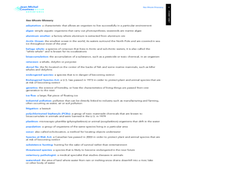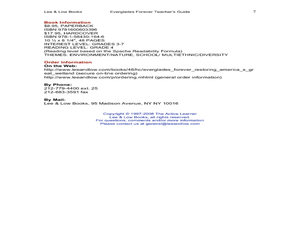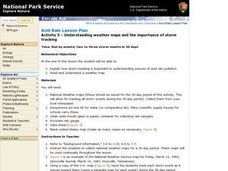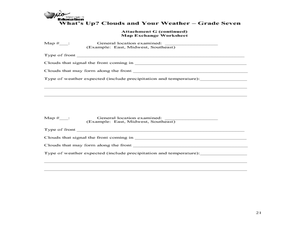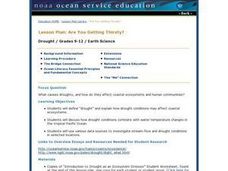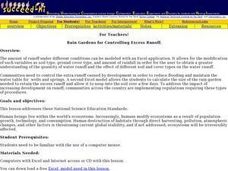Curated OER
Making Recycled Paper
Students explore the advantages of recycling paper. In this environmental lesson, students produce recycled paper by ripping up paper and putting it into a blender with water to create a mixture. Students use their recycled paper to...
Curated OER
Beluga Balancing Act
Students study beluga whale populations and the issues they face. In this beluga lesson students compare the issues that the whales are facing and name ways people can help.
Curated OER
What Do We Need In Our Environment To Survive?
Students discuss and write about waste management to save the environment. In this environment instructional activity, students discuss what an alien coming to Earth would notice about the environmental needs of humans for survival. They...
Curated OER
Everglades Forever
Students complete pre reading, writing, during reading, and interdisciplinary activities for the book Everglades Forever. For this reading lesson plan, students complete journal entries, answer short answer questions, have discussions,...
Curated OER
Problem Based Learning Scenario
Students research about the function of MPA's. In this marine science lesson, students explore how humans influence changes near these areas. They explore different MPA's in the Great Lakes region.
Curated OER
Desalination: Creating a Solar Still
To better understand how solar power can aid in creating desalinated drinking water, the class creates a model still. They will build a model of a solar still, make observations, and discuss how the process works. While the idea behind...
Curated OER
Biomes: Freshwater & Seawater
Middle schoolers observe organisms behavior and adaptations. In this biomes lesson students conduct fieldwork to determine water quality and answer questions about the differences between different habitats.
Curated OER
Acid Rain
Learners investigate the effects of acid rain. The lesson plan contains a lab background for the teacher to use before the implementation of the lesson plan. They conduct an experiment to collect data and then report the results of the...
Curated OER
Oil Slick Emergency
Pupils examine how to recover and remove oil from an oil spill. In this oil spill clean-up lesson students use role play and act like a committee to determine how to clean up an oil spill.
Curated OER
Erosion
Fifth graders study what erosion is, what causes it, and ways to slow its progress. They complete an experiment that depicts soil moving down a slope as water is poured on it to show how moving water erodes land. Next, they observe...
Curated OER
Does the Introduction of Pesticides and Fertilizers Alter an Aquatic Ecosystem?
Learners conduct an experiment using a small sample from a local water source. They introduce fertilizers and pesticides, separately, and carefully examine the results in their simulated aquatic ecosystem.
Curated OER
Cloud Types
Students examine cloud types. In this cloud lesson, students identify cloud types, observe clouds and collect data, and analyze data to identify the most common cloud they observe overhead during the course of a month.
Curated OER
Understanding Weather Maps and the Importance of StormT
Young scholars explain how storm tracking is important to understanding sources of acid rain pollution. The read and explain a weather map. They set up plastic or glass collection container for rain in an open area away from buildings...
Curated OER
Environmental Jobs
Pupils evaluate whether particular jobs have a positive or negative impact on the environment. In this career exploration lesson, students complete a worksheet in pairs to determine if and why various jobs impact the environment.
Curated OER
Mighty Macroinvertebrates
Seventh graders identify the names and features of macroinvertebrates found in Turtle River. In this ecology instructional activity students use digital microscopes and take pictures of invertebrates.
Curated OER
Trout Markings
Students paint a trout based on the pictures of trout coloration and markings they see in pictures. In this trout lesson plan, students understand that the markings on a trout are native to their habitats and create camouflage.
Curated OER
What's Up? Clouds and Your Weather
Seventh graders identify clouds and the weather that is associated with them. In this weather lesson students work in groups and design their own weather map.
Curated OER
White-tailed Deer Issues
Ninth graders examine the white tail deer population in Pennsylvania and explore the impacts that the deer have on the flora and fauna. For this white-tail deer lesson students complete an activity and graph their results.
Curated OER
Are You Getting Thirsty?
Students study droughts and how they affect communities and coastal ecosystems. In this ecosystems lesson plan students use data to examine drought conditions in certain areas.
Michigan Sea Grant
Fish Habitat and Humans
Strict habitat requirements are needed for the survival of fish populations and fish variety in the Great Lakes. Young scientists become experts in the basic needs of fish and understand how survival necessities can vary with different...
Curated OER
Avoiding Sports Injuries
Students research sports injuries and how to deal with the injury. In this injury prevention lesson, the teacher introduces several exercise risk factors and prevention techniques, then students work in small groups to conduct research...
Curated OER
Rain Gardens for Controlling Excess Runoff
Pupils address the idea that human beings live within the world' ecosystems. They discuss how humans modify ecosystems as a result of population growth, technology, and consumption. Students discuss how the human destruction of habitats...
Curated OER
World Geography: Who am I?
Students are able to provide a basic description of one country that has arsenic in its water supply. They are able to locate these countries on a map. Students explore the majors countries that have been affected by arsenic...
Curated OER
Land Use and Nitrogen
Students consider the effects of development on water quality. They test nitrogen levels in waters before and after development, investigate wastewater treatment options and research best management practices to reduce nitrogen loads.



